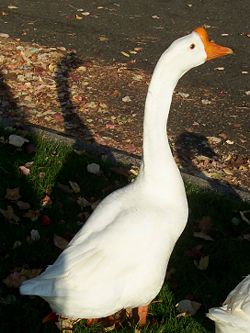Goose (domestic): Difference between revisions
Jump to navigation
Jump to search

imported>Petréa Mitchell (Written by me; various sources) |
imported>Ro Thorpe m (typo) |
||
| Line 4: | Line 4: | ||
The '''domestic goose''' is a domesticated species of the genus ''[[Anser]]'', kept as a food animal throughout the northern hemisphere. | The '''domestic goose''' is a domesticated species of the genus ''[[Anser]]'', kept as a food animal throughout the northern hemisphere. | ||
Goose meat is usually served in the form of a whole goose, roasted. In [[England]], a roast goose is a traditional centerpiece of a [[Christmas]] dinner. Goose liver, as [[foie gras]], is an | Goose meat is usually served in the form of a whole goose, roasted. In [[England]], a roast goose is a traditional centerpiece of a [[Christmas]] dinner. Goose liver, as [[foie gras]], is an important ingredient in [[French cuisine]]. | ||
Goose eggs may be prepared in a similar way to [[chicken]] eggs, but are rarely eaten. | Goose eggs may be prepared in a similar way to [[chicken]] eggs, but are rarely eaten. | ||
Domestic geese are also sometimes used as guard animals. | Domestic geese are also sometimes used as guard animals. | ||
Revision as of 13:55, 26 November 2007
The domestic goose is a domesticated species of the genus Anser, kept as a food animal throughout the northern hemisphere.
Goose meat is usually served in the form of a whole goose, roasted. In England, a roast goose is a traditional centerpiece of a Christmas dinner. Goose liver, as foie gras, is an important ingredient in French cuisine.
Goose eggs may be prepared in a similar way to chicken eggs, but are rarely eaten.
Domestic geese are also sometimes used as guard animals.
